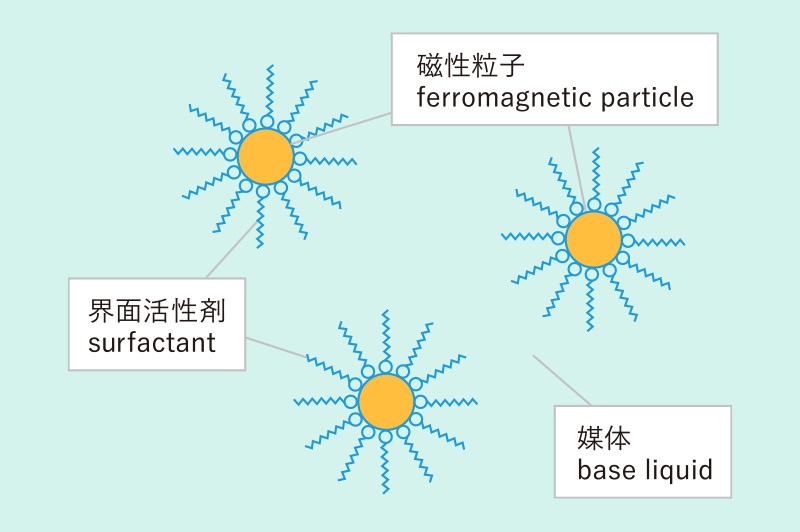What is a magnetic fluid seal?
A magnetic fluid seal is a kind of seal parts (sealing units) that is used to prevent leakage of gases.
A magnetic fluid seal is a seal unit for rotating parts and utilizes the sealing property of a mysterious “magnetic fluid” which is retained in the magnetic field by its attraction to the magnets.

What is a seal for rotating parts?
In a rotating part, there is a clearance, as shown in the image below, to avoid contact between the rotary and the fixed part (pole piece). In order to maintain the vacuum condition and the pressurized condition in a container, it is necessary to seal this clearance. The clearance is normally sealed with an O ring or an oil seal; however, rotations will cause wear overtime.


What is a seal for rotating parts?
A magnetic fluid is liquid but it is attracted, like iron, to magnets. In the 1960s, it was developed in connection with NASA’s space plan. A magnetic fluid consists of the following three components: ferromagnetic ultrafine particles such as magnetite and composite ferrite; a surfactant and base fluid such as water and oil. As the ferromagnetic ultrafine particles with the diameter of approx. 1/100000mm (10 nm) are coated with surfactants to inhibit agglomeration of particles, they maintain a stable dispersion state in the base fluid. This stable dispersion state will not be lost even in a strong magnetic field.


Internal mechanism
In a magnetic fluid seal, the magnetic fluid is retained along magnetic flux lines formed by magnets in the gap between a rotary shaft and a pole piece.
The magnetic fluid, which is retained in the gap by its attraction to the magnet, never flows out even with pressure differentials and works as a liquid-type O-ring.
The strength a magnetic fluid’s retention ability is determined by the magnetic force: the stronger the magnetic force is, the greater the pressure resistance of the magnetic fluid’s ring becomes.
By forming a multistage ring for this magnetic fluid, the magnetic fluid seal is made strong enough to withstand even quite large pressure differences.


Advantages of magnetic fluid seal
-
Contamiless
Contamiless
Because liquid is used for the sealing material, no solids come into contact between the rotary shaft and the pole piece, preventing particle generation due to friction.
-
Long service life
Maintenance free
With no solid contact between the rotary shaft and the solid part (pole piece), there will be no loss from wear on either of the parts, resulting in a with a long life and less maintenance.
-
High vacuum / High pressure resistance
High vacuum
High pressureBy using a low vapor pressure magnetic fluid, it can be used even in an ultra-high vacuum region of 10-6Pa or less.
Also, a magnetic fluid seal of pressure-resistant type can be used up to 1.0Mpa. -
High speed rotation
High speed rotation
The seal is formed with liquid, resulting in little torque being lost and high-speed rotation being enabled
Although a wide variety of dynamic seals are available, the following five seals are typically used to facilitate rotation in vacuum environments: magnetic fluid seals, oil seals (Wilson seals), O-ring seals. bellows seals, and magnetic-coupling seals.
As shown below in the table of comparison, magnetic fluid seals have more advantages than other types of seals.
| Magnetic fluid seals | Oil seals (Wilson seals) |
O-ring seals | Bellows seals | Magnetic-coupling seals |
|
|---|---|---|---|---|---|
| Vacuum region where the seals can be used |
Ultra-high vacuum | High vacuum | High vacuum | Ultra-high vacuum | Ultra-high vacuum |
| Rotational speed | High | Low | Low | Low | Low |
| Allowable transmission torque | High (dependent on the rotary shaft strength) |
High (dependent on the rotary shaft strength) |
High (dependent on the rotary shaft strength) |
Low | Low ※with lost motion |
| Dust generation | Extremely little | Great | Great | Little | Little |
| Service life | Long | Short | Short | Short | Short |
※ Lost motion is a delay in tracking generated during rotation, acceleration or deceleration.
